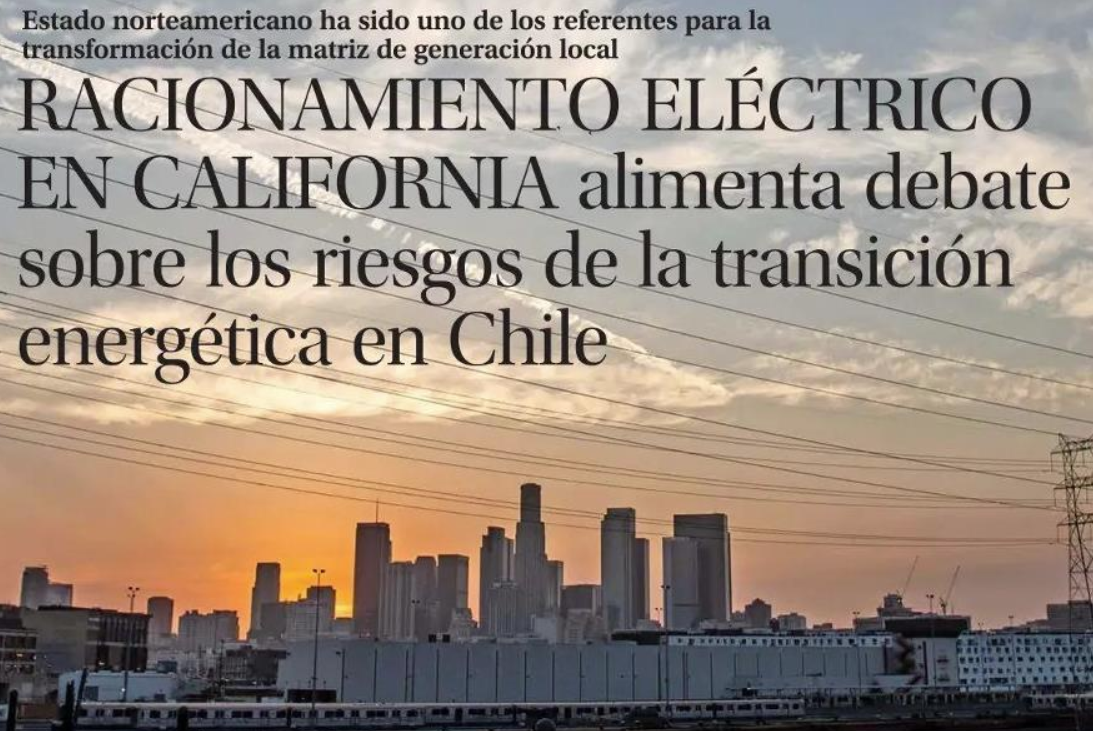
The measure affected 10% of the state’s population and was due to the impossibility of the system to meet peak demand with renewable generation alone, due to the early retirement of conventional backup capacity. Some saw in this episode a preview of what could happen in Chile in a few years.
+Jéssica Esturillo O.
Source: El Mercurio
In mid-August, the state of California had four days to forget. In addition to concerns about wildfires, which each year ravage this area of the United States with greater force, this year there were mobility restrictions due to the pandemic and a heat wave that in some areas raised the thermometers to 39°C (102°F). This cocktail caused electricity demand to rise so much that, although it did not break records, it caused the electricity system to collapse, as it was unable to cover peak consumption. The result? Scheduled supply cuts between Friday 14 and Monday 17 affected about 10% of the state’s population, that is, 3.3 million people out of a total of about 39 million.
The last time California had to apply such an extreme measure was 20 years ago, due to the energy price manipulation scandal that led to the Enron case. This time the outages angered local authorities who demanded investigations, and led to various accusations between the energy companies, the system operator and legislators.
Óscar Morales, project leader of the consulting firm Systep , explains that preliminary analyses show that the rationing in California had both structural and circumstantial causes. Among the former is the retirement of around 5,000 MW of natural gas units in the last three years, as part of the transition process towards a matrix with lower emissions, while among the conjunctural reasons are the forest fires and the reduction of electricity imports from neighboring states, also affected by high temperatures.
In practice, what happened is that peak electricity consumption occurred during the afternoon hours when renewable generation begins to decline. This, added to the retirement of conventional units, including one of the two nuclear power plants that supply the state (the second one will begin to close in 2024), meant that there was not enough energy, which also drove up the wholesale price of energy, which on Saturday, August 15, reached more than US$ 3,800 per MWh, a hundred times the usual price.
Experts agree that the problem in California is not the incorporation and future predominance of renewable generation, but that this decarbonization process has not occurred in conjunction with other technological, regulatory and market modifications. “California has been a global benchmark for two decades for good and bad news in energy matters, and to see what happened a few days ago is to see what could happen in Chile in ten years or less, if we do not take the proper precautions in decarbonization,” says Daniel Salazar, managing partner of the consulting firm EnergiE.
The also former executive director of the National Electric Coordinator (CEN), the entity that operates the local electric system, adds that while California has reached the extreme of rationing, Chile is discussing a bill that would force the closure of all coal-fired power plants by 2025. “How can we fail to see the risk we run by rushing a process that requires time that cannot be brief and that is already more accelerated than the original schedule. Decarbonization is much more than an itinerary with dates, it is a process that requires driving and that has not been there, we have only been filled with announcements that are presented for the maximalist positions that we see in Congress”, assures Salazar.
Morales agrees and comments that any regulatory process involving a significant modification of the generation park must be supported by technical, economic, environmental and social analyses that are currently being studied by CEN. “It must be determined whether the generation park, after retiring units, is capable of meeting the variations in solar and wind generation, as well as whether it could supply the demand in the event of temporary situations,” he says.
Systep’s data show that when the wind stops blowing and solar intensity drops, in a period of no more than four hours, the electricity system loses around 900 MW, equivalent to 9% of the maximum daily demand. “This variability will increase in the next three years, due to the planned commissioning of 3,000 MW of new wind power plants. Therefore, managing the variability of wind generation will become more important in the coming years,” says Morales.
Claudio Seebach, executive president of Generadoras, an association that groups electricity producers, says that although the Californian electricity system has important differences with the Chilean one, and the effects of climate change will be different across the planet, Chile is particularly vulnerable and this requires a robust and ambitious process of adaptation and therefore, he specifies, decarbonization must be structural, with advances in multiple dimensions, such as the retirement of coal-fired plants, the integration of renewable sources, and greater electrification of fossil-based consumption. “All these measures constitute technical challenges that require a regulatory update that is able to be predictable in order to continue to attract the investments required for the transition, and to achieve an electricity system that is flexible and resilient enough to respond to the operational needs required, for example, by extreme events such as those that occurred in California.





